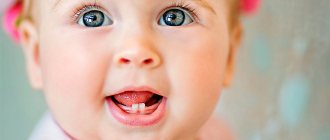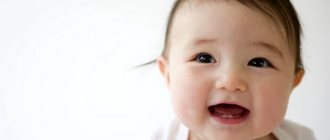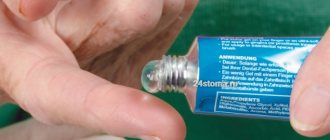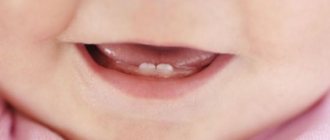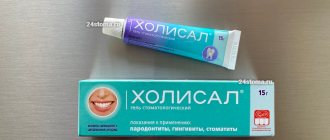Instructions for use
Teething in a child is a natural physiological process, the beginning of which many parents look forward to. The first baby teeth begin to appear at 6-8 months, and by 2.5-3 years all 20 teeth usually grow in. For many babies, this period is quite painful and difficult. In rare cases, teething does not show any symptoms, and parents discover new teeth by accident. It is a natural desire to protect your child from pain and discomfort. Fortunately, when teething, you no longer need to resort to traditional medicine methods and spend sleepless nights calming the baby. Modern dental products come to the rescue when teething in children, which have an analgesic and anti-inflammatory effect.
Pharmacology and pharmacodynamics
The medication has an antimicrobial effect and also has anti-inflammatory and analgesic effects.
The active ingredient choline salicylate relieves pain and inflammation at the site of application of the gel. The analgesic effect lasts for an average of 4-7 hours.
The second active element has a powerful antiseptic effect. Effectively copes with harmful bacteria.
The structure of the ointment promotes its rapid absorption into tissues, reaches the nerve endings in a short time and remains on the oral mucosa for a long time. Almost does not enter the blood.
Anti-inflammatory toothpastes for children –
In the arsenal of oral hygiene products for young children, there are several toothpastes that have an anti-inflammatory effect and reduce gum sensitivity during teething. Their use on an ongoing basis for child oral hygiene will increase the effectiveness of the use of gels for topical use or systemic homeopathic preparations (24stoma.ru).
- Weleda children's toothpaste-gel (from 0 to 3 years)
contains the following active components - calendula extract, alginate, esculin, essential oils of mint and fennel, which have an anti-inflammatory effect. Does not contain sodium lauryl sulfate, preservatives, dyes, fluorine. Price for a 50 ml tube – from 350 rubles (made in Germany).
- SPLAT “BABY Vanilla” paste (from 0 to 3 years) is made in Russia, and the active ingredients are licorice extract, prickly pear extract, arginine, a complex of lactic enzymes (lysozyme, lactoferrin, glucose oxidase, lactoperoxidase). Most of these components have an anti-inflammatory effect and reduce the sensitivity of the gums during teething. Price per tube 40 ml from 150 rubles.
- Foam SPLAT “Junior Magic Foam” (any age) – this foam for cleansing teeth contains licorice extract, a complex of lactic enzymes, as well as creatine and dipotassium glycyrrhizinate. All these components have an anti-inflammatory effect on the oral mucosa during teething. The cost will be starting from 260 rubles (per 50 ml tube).
What does Cholisal help with?
The gel is able to cope with inflammatory processes occurring in the oral cavity and various injuries. The drug should be taken for the following conditions:
- stomatitis;
- mechanical injuries and other damage resulting from wearing prostheses;
- for severe pain, as well as for prophylactic purposes after dental surgery;
- teething in babies;
- gingivitis.
When to suspect teething
The first teeth - the lower central incisors - can begin to erupt as early as three months, but in most cases their time comes at the age of 6-7 months.
Starting from this age, when symptoms appear that make it possible to suspect a cold or intestinal infection (we will talk about them later), first of all you should think about the fact that it could be teething and how to help the baby. Only after providing pain relief assistance, call a doctor and examine the child as prescribed. Teething occurs approximately according to this schedule:
| What kind of teeth | Time of eruption of baby teeth (months) | |
| Incisors | Lower central | 6–7 |
| Upper central | 8–9 | |
| Upper side | 9–11 | |
| Lower side | 11–13 | |
| Indigenous | The first (immediately behind the fangs) upper | 12–15 |
| First top | 12–15 | |
| Second (large) bottom | 24–30 | |
| Second top | 24–30 | |
| Fangs | Upper | 16–18 |
| Lower | 18–20 | |
It is especially important to know how to numb teething teeth in the following cases:
- at the age of 16–20 months, when the fangs grow: these are the teeth whose eruption is worst tolerated by children;
- if the first incisors began to appear closer to 11–13 months: the baby may have problems with the jaw bones, so any teeth he develops will be very painful;
- if the child was already born with defects of the dental-jaw system.
How to use Cholisal gel
The instructions indicate that the ointment is for external use only. It should be applied exclusively to the affected area of the mouth.
The product should be applied 20 minutes before or after meals. You can also rub the ointment in before going to bed. The procedure can be repeated up to 3 times a day. It will be enough for a child to use 0.5 cm, and for an adult – 1 cm.
If a person suffers from periodontal disease, then the ointment can be placed in the gum pockets that appear or effective compresses can be made.
Prevention of stomatitis in children
Prevention of stomatitis comes down to following basic hygiene rules. It is necessary to teach your child to regularly wash their hands and brush their teeth twice a day. In this case, the brush and paste should be selected in accordance with his age. If the child is still too small, then parents should help with hygiene procedures. It is also recommended to periodically wash toys, disinfect pacifiers and bottles, and keep the house clean.
Learn about other oral diseases
Scurvy Oral thrush Pathological tooth wear Stevens-Johnson syndrome
Adverse reactions and overdose
In some cases, after direct contact of the oral mucosa and the ointment, undesirable reactions may occur in the form of a burning sensation and tingling sensation. Such reactions are normal and disappear on their own after a few minutes. In rare cases, allergies may occur.
If serious side effects occur, you should stop using the gel and tell your doctor.
There are no cases of drug overdose. The ointment should not be swallowed; it is intended for external use only. If part of the medicine gets inside, then you need to rinse the stomach and, if necessary, begin symptomatic treatment.
How is stomatitis treated in children?
Every parent should understand that there is no single algorithm for treating stomatitis in a child. As we have already found out, many factors can contribute to the onset of inflammation. This means that treatment of stomatitis in a child must begin with eliminating the main cause that caused inflammation of the oral mucosa. Only a doctor can select complex therapy, based on the symptoms of the disease, the child’s age and other individual characteristics. Treatment usually includes taking medications, using local remedies for stomatitis in children (gels, ointments, applications), maintaining good hygiene, diet and sleep. Depending on the type of stomatitis, various medications are prescribed. Thus, for allergic stomatitis, antihistamines may be recommended, for herpetic stomatitis - antiviral drugs, and for aphthous stomatitis - antibiotics. It is strongly not recommended to resort to self-treatment, because the wrong choice of medication can aggravate the child’s condition.
Reviews about Cholisal
Most reviews about the use of the drug by adults and children are positive. The gel is able to quickly and effectively eliminate pain and inflammation and cools the affected area. If you use the medicine at night, the effect will last almost until the morning. Also has an antipyretic effect. For many, the advantage is that the composition does not contain lidocaine, to which many have adverse reactions and allergies.
There are many rave reviews from patients who had stomatitis. Within 3-5 minutes after application, you can notice a significant improvement in the condition, pain disappears, and after 15-20 minutes the inflammation is relieved. If you apply compresses before bed, then after a couple of days the signs of stomatitis will almost completely disappear.
The gel is sold in pharmacies. It can be bought without a doctor's prescription.
What symptoms indicate that teeth are being cut?
The first reason to pay attention to whether teeth are cutting, and how to help determine it, are the general symptoms:
Behavior change
The child either pushes his parents away or asks to be held. He often cries, refuses his favorite toys or pacifiers, and throws them on the floor.
In addition, the baby loses his appetite. When starting to eat, the child feels discomfort in the teething area, so the baby eats in small portions, and, having started to eat, cries after a short period of time. Sleep is disturbed: pain in the gum prevents him from falling asleep.
Most children indirectly show that they are teething, and every parent should know how to help. They:
- chew any hard objects they can reach;
- often reach for the breast or bottle, while hardly eating, but rolling (or gnawing) the nipple or pacifier in the mouth.
In general, it is worth considering that teeth are being cut and how to help with this if the baby has become “unbearable” for no apparent reason.
Please note: these symptoms should not last longer than two to three days and should end with the appearance of a small area of tooth above the gum.
Increased salivation, chin irritation and wet cough
These are interrelated symptoms:
- Salivation increases as a result of three reasons:
- irritation of the gum tissue and the nerve endings located in it by the erupting tooth;
- physiologically - due to the baby adopting a new position for him - sitting, which coincides with teething;
- difficulty swallowing saliva.
- A wet cough is a consequence of a large amount of saliva. The baby still lies more often than sits, so saliva flows down the back wall of the throat and enters the respiratory tract. If the cough is caused specifically by teething, it occurs in the morning and is almost not observed during the day when the child is awake.
- Redness and rash on the chin also occur due to the abundance of saliva that flows onto the skin.
If you see such signs of teething in your child, how to relieve pain, read on.
Runny nose
The appearance of light, watery discharge from the nose is possible due to teething. This type of runny nose may be accompanied by sneezing, but ends within 3-4 days without complications. If the snot becomes yellow or green, or the cough gets worse and the child becomes lethargic, check with your pediatrician. In such a situation, the question “how to numb teething teeth”, as a rule, does not arise.
Changing the appearance of your gums
2–3 weeks before the eruption of a canine, incisor or molar, an enlarged blue area (hematoma) may appear on the gum. This is not accompanied by unpleasant symptoms, and the child behaves as usual.
A change in the appearance of the gums when the symptoms described above appear helps to understand that teeth are being cut and how to help - this is the most important question at the moment. In this case, the gum becomes reddish and swollen; touching it causes discomfort in the child and a desire to bite the object being touched. These local signs disappear after the tooth appears above the gum. Sometimes teething is accompanied by the release of a small amount of blood.
Controversial symptoms
Often, against the background of the eruption of incisors, canines or molars, the child experiences symptoms that are very reminiscent of some kind of infection - respiratory or intestinal:
- temperature rise above 37.5°C
- diarrhea;
- vomit;
- pain in the ear or maxillary sinus;
- lethargy.
Both the parents themselves and the pediatrician can associate these signs with teething. But in fact, the child needs examination. Because teething often coincides with ARVI or intestinal infection.
This is justified: immunological studies prove that immunity decreases physiologically during this period. That is, if previously a child could easily cope with a pathogenic microbe, now it is difficult to resist it.
To understand whether it is an infectious disease or teething and how to help, an examination by an ENT doctor is often enough. After examining the throat, nose and ears, he will tell you whether there are signs of inflammation there or not. If the ENT organs are in order, perhaps such symptoms are still associated with a dental problem.
Diarrhea that occurs against the background of teething requires consultation with an infectious disease specialist. Especially if loose stools are observed more than 3 times a day or are accompanied by an increase in temperature.
Metrogyl denta for stomatitis
In order to quickly cure stomatitis, you need to start therapeutic actions as early as possible. Metrogyl denta for stomatitis is an effective drug that helps stop a spreading infection at an early stage. Metrogyl gel adheres well to the mucous membrane without being absorbed into the deep layers of tissue, thereby capturing and limiting foci of inflammation. In addition to its antimicrobial effect, the drug relieves burning and itching well, the effect lasts up to 12 hours, after which the gel can be applied again.
Metrogil denta for stomatitis has the following advantages and positive characteristics:
Symptoms of seizures
Streptococcal infection is usually diagnosed in children. Inflammation begins with the appearance in the corner of the mouth of a phlegm (bubble) with a flaccid thin lining. In place of the bubble, a slit-shaped erosion quickly forms, covered with a purulent-bloody crust. After its removal, a red, moist, easily bleeding surface is exposed, often with a crack in the center. After 1-2 hours, the crust becomes crusty again. The process may be accompanied by slight pain when opening the mouth.
Candidiasis is characterized by the formation of a varnish-red erosion in the corner of the mouth, surrounded by macerated epithelium. Sometimes the erosion is covered with an easily removable grayish-white coating. Unlike streptococcal seizures, with candidiasis there are no crusts on the surface of the erosion and usually, when the patient’s mouth is closed, it is masked by an overhanging fold of skin. The disease often has a chronic relapsing course.
The diagnosis is made based on the clinical picture. The shape of the seizure is confirmed by laboratory tests. In scrapings from the surface of the erosion, a bacterioscopic examination reveals a large number of budding yeast cells or streptococci.
With candidiasis, other manifestations of candidiasis may be observed. Zaedu should not be confused with erosive papules of syphilis, which are distinguished by the presence of compaction at the base of the erosion, pale treponemas in the discharge, as well as with other signs of syphilis, for example, positive serological reactions to syphilis.
Cholisal during pregnancy
The timing of teething can characterize both the biological and passport age of the child. The process and timing of teething depend not only on inherited genetic parameters, that is, how they erupted in mom and dad, and even in ancestors in the seventh generation. But the timing of teething can be influenced by external and internal factors. For example: climatic conditions, diet, quality of drinking water, etc. In this regard, the timing of the eruption of permanent teeth varies in different regions. The hotter the climate. The earlier teeth usually erupt. Although this is also not an axiom.
Baby teeth usually begin to emerge at 6-8 months. A one-year-old baby, as a rule, celebrates his first birthday with four upper and lower incisors in his mouth. By the age of two, the first primary molars and canines erupt. Second primary molars appear after another six months. Complete formation of the primary dentition is usually completed at three years of age. By the age of three, a child should have grown all 20 baby teeth.
What to do if by 9 months your child has not yet erupted a single tooth? First of all, don’t worry ahead of time. Dentists consider a delay in the eruption of primary teeth within 6 months to be completely natural. However, boys tend to erupt teeth later than girls.
Start by carefully examining your baby’s gums: it is very likely that they look swollen and reddened, or, on the contrary, the gums are thin and pale, and the edge of the tooth can be felt underneath and even visible. In order to speed up teething, buy special ring toys - teething stimulators. A light massage of the gums with a clean finger or a cold teaspoon is also useful. Pressure on the gums facilitates and speeds up teething, and cold reduces discomfort.
Delays in teething can be caused by general growth retardation due to a number of child diseases, primarily rickets. Consult your pediatrician: your baby may need vitamins or calcium supplements to maintain normal mineral metabolism.
In rare cases, children have edentia - the absence of tooth buds. So if your baby is over a year old and his teeth have not yet begun to emerge, you should consult a dentist. You can check the presence of tooth germs using an x-ray. X-ray irradiation may be unsafe for a child’s body, so this study should be performed only when necessary and as prescribed by a doctor. Today it is possible to reduce the harmful effects of X-rays if you take a picture using a radiovisiograph. Such equipment is usually available in every modernly equipped dental clinic.
Symptoms of teething in a child.
How to determine that a child is already cutting his first tooth? Symptoms of a baby's first teeth erupting include red, inflamed gums, burning cheeks and, possibly, an already swollen white ball from which a tooth is about to emerge. True, he can make himself wait. Before being exposed, the tooth must first pass through the bone tissue that surrounds it, and then through the mucous membrane of the gums. Is it necessary to somehow help teething? You should not interfere with the natural course of events, because nature has provided that children’s teeth are born independently, without special external efforts or additional devices. There is no need to irritate your baby's gums by scratching them with a piece of sugar or the handle of a spoon, as was done before. This can damage delicate baby teeth and cause infection in the jaw bone. Be careful with bagels, bread crusts, bagels: their crumbs can get stuck in the respiratory tract.
During a person’s life, 20 teeth change once, and the remaining 8-12 teeth do not change; they erupt initially as permanent teeth (molars).
Teething. First (medial) lower incisors - 6-9 months. First (medial) upper incisors - 7-10 months. Second (lateral) upper incisors - 9-12 months. Second (lateral) lower incisors - 9-12 months. First upper molars - 12-18 months. First lower molars - 13-19 months. Upper canines - 16-20 months. Lower canines - 17-22 months. Second lower molars - 20-33 months. Second upper molars - 24-36 months.
These tables are approximate. According to statistics, the first tooth in modern infants appears on average only at 8 and a half months. Thus, the timing of the eruption of other teeth is shifted. Dentists believe that the later the first tooth erupts, the later the baby teeth will begin to fall out and this is undoubtedly good. However, before the baby is one year old, at least one tooth must appear, otherwise the causes should be looked for in some diseases, for example, rickets. The first tooth can come in pairs, and the same is true with subsequent teeth. It happens that a baby has 4 teeth at once. Naturally, such “massive” growth of teeth affects the timing of teething. The situation is also uncertain with the order in which teeth appear; you simply cannot influence this, so “don’t worry in vain,” because everything goes as nature intended.
By the age of three, all baby teeth erupt in a child, which by the age of 5 begin to gradually be replaced by permanent ones.
There are 20 primary teeth in total: on each jaw there are 4 incisors (4 central teeth), 2 canines (third teeth) and 4 molars (fourth and fifth teeth). An adult normally has 28-32 permanent teeth: each jaw has 4 incisors, 2 canines, 4 premolars and 4-6 molars. The development of the third molar (“wisdom tooth”) may not occur at all, with congenital edentia of the third molars, which is also considered normal. Another situation is also possible: a wisdom tooth is embedded in the thickness of the jaw, but never erupts due to incorrect position or lack of space in the jaw. This situation occurs very often.
After all the baby teeth have erupted, there are no gaps (gaps, gaps) between them, which is normal. But as the jaw grows, before the baby teeth are replaced by permanent ones, gaps should appear between the baby teeth. This process is necessary because permanent teeth are larger in size than baby teeth and if spaces are not formed, then the permanent teeth do not fit in the jaws and the child receives “crooked” permanent teeth. In parallel with the formation of spaces between temporary teeth, the roots of baby teeth are “reabsorbed”, after which the teeth alternately become loose and fall out. Nowadays there is even a fashion to buy a box made of gold or silver to store the first teeth.
There is no general opinion about the normal timing of teething, since scientific studies by different authors were carried out in different regions and in different years of the last and present century.
If it hurts a lot...
Teething may be accompanied by increased excitability: the child becomes restless, capricious, often wakes up crying at night, and may refuse to eat. At the same time, the baby puts any object in his mouth, since chewing reduces the itching of irritated gums. The secretion of saliva is sharply increased, which, flowing from the mouth, can cause skin irritation. Often, a limited area of redness or rash appears on the cheek on the side of the erupting tooth. The child's temperature may rise to subfebrile levels (within 37.8°). However, fever does not necessarily accompany teething.
During teething, one or another infection may develop. Therefore, if your baby develops symptoms such as nausea, vomiting, ear pain, diarrhea, cough, rash, persistent loss of appetite or high fever, you should consult a doctor.
What remedies relieve pain? The simplest thing is cold. Cold relieves pain and reduces swelling. If this does not help, you can use dental gel or ointment containing anti-inflammatory and pain relievers to lubricate the gums. If necessary, you can give your child a pain reliever. Any medications should be used only as prescribed by a doctor.
Here are common questions worried moms ask.
What to do if teeth erupt at the wrong time? Nothing to do. There is no clear concept of “late teething”, or rather “teething dates” are relative, generally accepted terms, and not strict data. These terms are determined by average values and depend on neonatal (how the birth went) indicators, physical constitution, individual characteristics of the baby, etc. So, no matter what time teeth erupt, this period is normal for this child. By the way, the same applies to the eruption of permanent teeth and wisdom teeth. Only in rare cases of obvious pathologies can the timing of eruption really be abnormal.
The later teeth erupt, the healthier they are? Unfortunately, this is not the case - the timing of teething and their “quality” are in no way connected.
What sedatives can be used in children during teething? Do these drugs affect the teething process? No, these drugs do not affect the teething process in any way. They have all been clinically tested and naturally have no side effects. The only limitation is children with allergies, but there is also a sedative for them - Doctor Baby. Almost all such gels contain lidocaine and inert fillers (menthol for cooling, flavoring agents and astringents). I can recommend the following drugs:
Dentinox Kalgel is sweet and should not be used if you have diathesis. Kamistad is very effective, but must be used in moderation. Mundizal Cholisal “Solcoseryl” dental paste (available for external use, do not confuse it) – is especially effective if there are bleeding wounds or painful ulcers. Dr. Baby – for lidocaine allergies
How often can soothing gels be used? Soothing gels do not need to be used according to a specific regimen (such as antibiotics). If it hurts, you apply it, if it doesn’t hurt, don’t apply it. But don’t get too carried away, it’s better not to use it more than 3-4 times a day and more than 3 days in a row.
How to speed up teething? No medication. A method proven over the years is a gentle massage of the gums. Gently massage the gums with a clean finger and the child will feel better, and the tooth will erupt a little faster. Just don't press hard, don't injure yourself. Usually they give the child a cold spoon to suck on, but you can also keep the pacifier in the refrigerator for a little while and give it to the child. There are special teethers with coolant. Place in the refrigerator. Then you give it to the child to chew on. But don't overdo it.
Can bad breath occur during teething and what is the reason for this? During teething, the mucous membrane partially decomposes (lysis). Salivary enzymes play an active role in this process. As you know, the amount of saliva increases during teething. This is due specifically to the lysis process. This can actually change the viscosity, color and smell of saliva. In addition, saliva contains weak antibacterial substances that prevent infection of the wound formed during tooth eruption. Their active influence can also change the normal properties of saliva. A certain amount of blood also enters the oral cavity, and when it decomposes, a sour (metallic) odor may also arise.
What to do if the temperature rises sharply during teething? In principle, a slight increase in temperature during teething is normal. But she won't be 39-40. This does not happen when teething. Caution: Teething should not cause high fever, diarrhea, vomiting, complete loss of appetite, cramps or choking. If you experience these symptoms, even if you think they are related to your teeth, consult your doctor. It is also not recommended to give a child an antipyretic and analgesic (syrup, suppositories) without consulting a doctor and at a body temperature below 38.5 C.
How can children distinguish between an increase in temperature during teething and an increase in temperature for some other reason? How long can a fever last during teething? Everything is individual, but generally hyperthermia and diarrhea are only secondary signs of teething. For a very small organism, this is a severe physiological fracture. Now most pediatricians and physiologists admit that increased temperature during teething is most likely a reaction to inflammation of the oral mucosa. At the site where the teeth emerge, irritation forms, often a wound (from friction and due to lysis), and often the wound becomes infected. So hyperthermia is caused not by the mechanism of tooth formation itself, but by side effects. One of the arguments in favor of this opinion is that when permanent teeth erupt, despite the similarity of histological and physiological changes, such symptoms almost never occur.
The occurrence of cold and diarrhea symptoms is explained by a sharp change in diet and diet, constant foreign objects in the mouth and microflora disturbance, as well as a weakening of local immunity in the nasopharynx. From this we can conclude that if the fever and loose stools continue for too long (more than 72 hours), then the reason most likely is not teething.
Possible features of teeth in children at the teething stage:
Expansion of spaces between teeth. It may reflect increased jaw growth and during the transition period from baby teeth to permanent teeth is regarded as a normal condition. A wide gap between the front incisors on the upper jaw is usually associated with a deep-lying maxillary frenulum. The tactics for monitoring and treating wide gaps between teeth are determined by an orthodontist.
A blackish edging on the neck of the tooth can be due to the use of soluble iron preparations or a chronic inflammatory process (precipitation of bacteria of the leptotrichium group);
Yellowish-brown staining of teeth is most often associated with the use of antibiotics by the mother in the second half of pregnancy or by the child during the period of teeth formation.
A yellowish-greenish color develops in severe disorders of bilirubin metabolism and hemolytic (destruction of red blood cells) conditions;
Reddish staining of tooth enamel is characteristic of a congenital disorder of pigment metabolism - porphyrin. This disease is called porphyria;
Malocclusions occur due to uneven growth of the jaws, due to prolonged sucking of the nipple; Anomalies in the location of teeth occur for constitutional reasons (small jaw size), due to trauma, congenital disorders of connective tissue metabolism, and tumors of the alveolar process of the jaw.
The absence of teeth before 1 year of age is extremely rarely associated with edentia - the absence of their rudiments. You can check the presence of tooth germs using a special radiovisiography method prescribed by a pediatric dentist.
Atypical situations.
Timely growth of teeth in a certain sequence indicates the normal development of the baby’s body. This is a physiological process and is directly related to the general health of the child. But let’s consider some atypical situations that may indirectly indicate the presence of pathology. However, only indirectly. Let us make a reservation once again that only careful research can confirm or refute these assumptions.
1) A delay in the timing of eruption (longer than 1-2 months from the norm) may be a consequence of rickets, an infectious disease, prolonged dysfunction of the intestines and changes in metabolism. 2) Earlier teething (before 1-2 months before normal) may indicate endocrine disorders. 3) Violation of the order, the absence of one or another tooth can also be the result of some anomalies in the child’s health (there are isolated cases when even the rudiments of teeth are missing) or be a consequence of diseases suffered by the mother during pregnancy. 4) The eruption of a tooth outside the arch of the dentition can be caused by an incorrect position of the tooth axis (horizontal or oblique). 5) Incorrect formation of the tooth itself - size, shape, position, color, lack of enamel coating, etc. The causes of these phenomena should be analyzed by a specialist. 6) The appearance of teeth even before birth. Such situations are extremely rare. Such teeth prevent the baby from sucking at the mother's breast; they are usually removed.
Here are some things to remember when teething:
Regularly rub your baby's face with a special towel to remove saliva and prevent skin irritation; it is better not to rub, but to gently blot the saliva so as not to cause irritation around the mouth. Place a clean, flat cloth under the baby's head to absorb any drool. When the napkin gets wet, you won't have to re-make the sheet.
Give your child something to chew on. Make sure the item is large enough that your child won't swallow it or chew it into small pieces. A damp washcloth placed in the freezer for 30 minutes can be a good solution, just remember to wash it after each use. Special teething rings, which are sold in pharmacies, are also effective. If you are using rings, do not freeze them until they turn to stone to avoid damaging your weak gums. Never tie a teething ring around your baby's neck to avoid getting caught in the band. Gently massage your baby's gums with a clean finger.
Never put aspirin or other tablets on your teeth, or rub alcohol-containing solutions into your gums. If your child is not feeling well, paracetamol in pediatric dosage may help. BUT FIRST CONSULT YOUR DOCTOR!
When teeth appear, you need to start caring for them. A child up to 1-1.5 years old can brush his teeth once a day with a special soft plastic brush (put on the mother’s finger). In this case, it is convenient to sit the baby on your lap, with his back to you. For an older child, you can buy the first children's toothbrush of a comfortable size, with durable bristles. At this age, children imitate adults with pleasure, and the ritual of morning and evening brushing of teeth is easily established. It is clear that the baby is still playing with brushing his teeth, and while the mother is brushing them - it is most convenient to stand behind the baby in front of the mirror. From the age of two, you can teach your child to rinse his mouth with water (it would be good to do this every time after eating) and use children's toothpaste. You may have to try several brands of toothpaste before your baby is satisfied with the new taste.
Other measures to prevent caries (baby teeth are more fragile than permanent teeth and are affected in a shorter time!) include monitoring the amount of sweets in the child’s diet and avoiding sweet drinks (juices, sweet water) at night and at night.
Your child should see the dentist for the first time when he or she is one year old. However, if you are worried about something - irregular teething, darkening of the tooth, stains on it, bad breath - consult a doctor as soon as possible. The health of baby teeth is the key to the proper formation and health of permanent teeth.
How to prevent tooth decay
1. Do not lick the pacifier or use a baby spoon to taste your baby's food. This will protect your baby's mouth from bacteria found in an adult's saliva. 2. If possible, reduce the sugar content in your child's diet. Offer water or natural juice instead of sweetened drinks, and never give sugary drinks as a sleep aid at night. 3. Teach your one-year-old baby to drink a few sips of water after eating, and after two years - to rinse his mouth after eating. 4. Bring your child to the dentist regularly for examinations. The first time this can be done is two years old. If problems arise earlier, do not delay going to the doctor. Check your child's teeth at least once every six months. 5. Try to prevent dental injuries. If the enamel is damaged, they are destroyed faster. Strengthen your baby's teeth with a healthy menu. Include in your child's daily diet 10 - 20 g of hard cheese, a few tablespoons of seaweed, 5 - 6 raisins, 1 - 2 dried apricots, green and black tea (rich in fluoride). 6. The child should brush his teeth after every meal or at least twice a day, including always before bed.
Have you cut your teeth? It's time to clean
Immediately after teething, the child’s teeth are exposed to aggressive environmental influences. Microbes settle on the teeth, forming a film of plaque. Acids are actively produced in dental plaque. Under their influence, the enamel of baby teeth is easily destroyed and a carious cavity is formed.
Acid production occurs especially actively in the presence of sugar. Therefore, the cause of the development of caries in the first years of life is often an early transition to artificial feeding, especially if the child sucks sweet milk formulas or juices from a bottle for a long time.
You need to start regular oral care before teething. Using a moistened sanitary napkin placed on a clean finger, carefully wipe the mucous membrane of the cheeks and gums. Newly erupted incisors are also first wiped with a napkin.
In the second year of life, it is time to start using a toothbrush. Today there are special toothbrushes on sale - they are small and have especially soft bristles. For example, I can recommend the “My First Colgate” brush. Funny bright toys decorating the handle of this brush will form a positive attitude towards brushing your teeth in your child.
Until two years of age, we recommend that parents clean their baby’s teeth simply with a damp toothbrush. From the age of two you can start using toothpaste. It is best if it is a paste containing fluoride. However, it should be remembered that a small child tends to swallow toothpaste while brushing, so up to 6 years of age it is better to use children's toothpastes with a reduced fluoride content. For one-time brushing, it is enough to use a small amount of fluoride toothpaste - about the size of a pea.
The risk of early development of caries is increased with insufficient fluoride content in drinking water. This situation occurs, for example, in Moscow and St. Petersburg. Children from 2 to 14 years old need compensation for the daily intake of fluoride into the body. Your child's pediatrician or pediatric dentist should determine the recommended daily dose of sodium fluoride tablets or drops for your child.
Release form, composition and packaging
◊ Dental gel
in the form of a colorless, transparent, homogeneous mass with the smell of anise oil.
| 1 g | |
| Choline salicylate | 87.1 mg |
| cetalkonium chloride | 0.1 mg |
Excipients: hyaetellose – 20 mg, methyl parahydroxybenzoate – 1.5 mg, propyl parahydroxybenzoate – 0.8 mg, glycerol – 50 mg, anise seed oil – 1.61 mg, ethanol 96% – 390 mg, water – up to 1000 mg.
Attention!
To make information easier to understand, these instructions for use of the drug “Gel for Stomatitis” have been translated and presented in a special form based on the official instructions for medical use of the drug. Before use, read the leaflet included directly with the medication.
The description is provided for informational purposes and is not a guide to self-medication. The need to use this drug, the prescription of the treatment regimen, methods and doses of the drug are determined solely by the attending physician. Self-medication is dangerous for your health.
